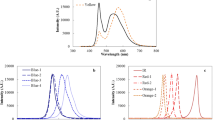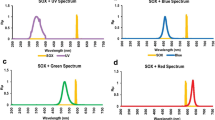Abstract
The red microalga Rhodella reticulata, a potential source of bioactive substances, was the subject of study of the irradiance and temperature effects on growth rate and biochemical composition of algal biomass. The optimum temperature for growth decreased from 28 to 26°C with increasing light intensity from 260 to 520 µE/(m2 s). The maximal growth rate was 0.21/day at 28°C and lower light intensity (260 µE/(m2 s)). Variations in these parameters also affected the fatty acid productivity, and proteins and carbohydrates content. At 34°C and high light intensity the quantity of carbohydrates was 1.16-fold higher than the quantity at the optimal temperature and low light intensity. Protein content was the highest at lower temperatures for both light intensities. Fatty acid profile showed the highest percent for the polyunsaturated eicosapentaenoic acid (EPA) at 28°C and both light intensities (46% from the whole fatty acid content), an important feature for this strain. This is a prerequisite for use of EPA as a supplement in food industry.
Similar content being viewed by others
Abbreviations
- ADW:
-
absolutely dry weight
- EPA:
-
eicosapentaenoic acid
- PUFAs:
-
polyunsaturated fatty acids
References
Adarme-Vega, T.C., Lim, D.K.Y., Timmins, M., Vernen, F., Li, Y., and Schenk, P.M., Microalgal biofactories: a promising approach towards sustainable omega-3 fatty acid production, Microb. Cell Fact., 2012, vol. 11, pp. 96–106.
Sandnes, J.M., Källqvist, T., Wenner, D., and Gislerød, H.R., Combined influence of light and temperature on growth rates of Nannochloropsis oceanica: linking cellular responses to large-scale biomass production, J. Appl. Phycol., 2005, vol. 17, pp. 515–525.
Boelen, P., van Dijk, R., Sinninghe, Damsté, J.S., Rijpstra, W.I., and Buma, A.G., On the potential appli-cation of polar and temperate marine microalgae for EPA and DHA production, AMB Express., 2013, vol. 3, pp. 26–35.
Patil, V., Källqvist, T., Olsen, E., Vogt, G., and Gislerød, H.R., Fatty acid composition of 12 microalgae for possible use in aquaculture feed, Aquacult. Int., 2007, vol. 15, pp. 1–9.
Von Schacky, C., Omega-3 fatty acids: antiarrhythmic, proarrhythmic or both, Curr. Opin. Clin. Nutr. Metab. Care, 2008, vol. 11, pp. 94–99.
Ruxton, C.H.S., Calder, P.C., Reed, S.C., and Simpson, M.J.A., The impact of long-chain n-3 polyunsaturated fatty acids on human health, Nutr. Res. Rev., 2005, vol. 18, pp. 113–129.
Carvalho, A.P. and Malcata, F.X., Kinetic modeling of the autotrophic growth of Pavlova lutheri: study of the combined influence of light and temperature, Biotechnol. Prog., 2003, vol. 19, pp. 1128–1135.
Chen, S.Y., Pan, L.Y., Hong, M.J., and Lee, A.C., The effects of temperature on the growth of and ammonia uptake by marine microalgae, Bot. Stud., 2012, vol. 53, pp. 125–133.
Korbee, N., Figueroa, F.L., and Aguilera, J., Effect of light on the accumulation of photosynthetic pigments, proteins and mycosporine-like amino acids in the red alga Porphyra leucosticte (Bangiales, Rhodophyta), J. Photochem. Photobiol., 2005, vol. 80, pp. 71–78.
Bernard, O. and Rémond, B., Validation of a simple model accounting for light and temperature effect on microalgal growth, Biores. Technol., 2012, vol. 123, pp. 520–527.
Dilov, C., Georgiev, D., and Bozhkova, M., Cultivation and application of microalgae in the People’s Republic of Bulgaria, Arch. Hydrobiol., 1985, vol. 20, pp. 35–38.
Ivanova, J., Kabaivanova, L., Petrov, P., and Yankova, S., Optimization strategies for improved growth, polysaccharide production and storage of the red microalga Rhodella reticulata, Bulg. Chem. Commun., 2015, vol. 47.
Makarevičienė, V., Skorupskaitė, V., and Andruleviiütė, V., Biomass and oil production of green microalgae Scenedesmus sp. using different nutrients and growth, Environ. Res. Eng. Manage., 2012, vol. 4, pp. 5–13.
Li, H., Li, Z., Xiong, S., Zhang, H., Li, N., Zhou, S., Liu, Y., and Huang, Z., Pilot-scale isolation of bioactive extracellular polymeric substances from cell-free media of mass microalgal cultures using tangential-flow ultrafiltration, Proc. Biochem., 2011, vol. 46, pp. 1104–1109.
Lowry O., Rosenbrough, N., Farr, A., and Randall, R., Protein measurement with the Folin phenol reagent, J. Biol. Chem., 1951, vol. 193, pp. 265–275.
DuBois, M., Gilles, K.A., Hamilton, J.K., Rebers, P.A., and Smith, F., Colorimetric method for determination of sugars and related substances, Anal. Chem., 1956, vol. 28, pp. 350–356.
Iliev, I. and Petkov, G., Growth, lipids and fatty acids of the desert tolerant blue-green alga Arthronema africanum, Compt. Rend. Acad. Bulg. Sci., 2006, vol. 9, pp. 1079–1082.
Vonshak, A., Torzillo, G., Boussiba, S., Millie, D.F., and Kurgens, P., Temperature induced photoinhibition in outdoor cultures of Monodus subterraneus, J. Phycol., 2000, vol. 36, pp. 69–78.
Cassidy, K.O., Evaluating Algal Growth at Different Temperatures, Master’s Thesis, Theses and Dissertations–Biosystems and Agricultural Engineering, Lexington, USA: University of Kentucky, 2011, paper 3, http://uknowledge.uky.edu/bae_etds/3
Kim, H.W., Vannela, R., Zhou, C., and Rittmann, B.E., Nutrient acquisition and limitation for the photoautotrophic growth of Synechocystis sp. PCC6803 as a renewable biomass source, Biotech. Bioeng., 2011, vol. 108, pp. 277–285.
Renaud, S.M., Thinh, L.V., and Parry, D.L., The gross composition and fatty acids composition of 18 species of tropical Australian microalgae for possible use in mariculture, Aquaculture, 1999, vol. 170, pp. 147–159.
Sukenik, A. and Wahnon, R., Biochemical quality of marine unicellular algae with special emphasis on lipid composition. I. Isochrysis galbana, Aquaculture, 1991, vol. 97, pp. 61–72.
Wen, Z.Y. and Chen, F., A perfusion-cell bleeding culture strategy for enhancing the productivity of eicosapentaenoic acid by Nitzschia laevis, Appl. Microbiol. Biotechnol., 2001, vol. 57, pp. 316–322.
Martins, D.A., Custodio, L., Barreira, L., Pereira, H., Ben-Hamadou, R., Varela, J., and Abu-Salah, K., Alternative sources of n-3 long-chain polyunsaturated fatty acids in marine microalgae, Mar. Drugs, 2013, vol. 11, pp. 2259–2281.
Mihova, S., Minkova, K., Petkov, G., and Georgiev, D., Thermal and photoregulation of the lipid and fatty acid content in cells of Porphyridium sordidum, Compt. Rend. Acad. Bulg. Sci., 1996, vol. 49, pp. 109–118.
Georgiev, D., Minkova, K., Petkov, G., and Sholeva, M., Lipid extraction from Porphyridium cruentum dry biomass, Compt. Rend. Acad. Bulg. Sci., 1992, vol. 45, pp. 131–134.
Hoffmann, M., Marxen, K., Schulz, R., and Vanselow, H.K., TFA and EPA productivities of Nannochloropsis salina influenced by temperature and nitrate stimuli in turbidostatic controlled experiments, Mar. Drugs, 2010, vol. 8, pp. 2526–2545.
Klyachko-Gurvich, G.L., Tsoglin, L.N., Doucha, J., and Kopetskii, J., Shebalina (Ryabykh), I.B., and Semenenko, V.E., Desaturation of fatty acids as an adaptive response to shifts in light intensity, Physiol. Plant., 1999, vol. 107, pp. 240–249.
Khotimchenko, S.V. and Yakovleva, I.M., Lipid composition of the red alga Tichocarpus crinitus exposed to different levels of photon irradiance, Phytochemistry, 2005, vol. 66, pp. 73–79.
Thompson, G.A., ffixJr., Lipids and membrane function in green algae, Biochim. Biophys. Acta, 1996, vol. 1302, pp. 17–45.
Guiheneuf, F., Mimouni, V., Ulmann, L., and Tremblin, G., Combined effects of irradiance level and carbon source on fatty acid and lipid class composition in the microalgae Pavlova lutheri commonly used in mariculture, J. Exp. Mar. Biol. Ecol., 2009, vol. 369, pp. 136–143.
Author information
Authors and Affiliations
Corresponding author
Additional information
The article is published in the original.
Rights and permissions
About this article
Cite this article
Ivanova, J.G., Kabaivanova, L.V. & Petkov, G.D. Temperature and irradiance effects on Rhodella reticulata growth and biochemical characteristics. Russ J Plant Physiol 62, 647–652 (2015). https://doi.org/10.1134/S102144371504010X
Received:
Published:
Issue Date:
DOI: https://doi.org/10.1134/S102144371504010X




